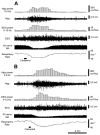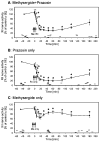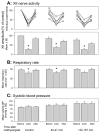REM sleep-like atonia of hypoglossal (XII) motoneurons is caused by loss of noradrenergic and serotonergic inputs
- PMID: 16100007
- PMCID: PMC5222563
- DOI: 10.1164/rccm.200412-1750OC
REM sleep-like atonia of hypoglossal (XII) motoneurons is caused by loss of noradrenergic and serotonergic inputs
Abstract
Rationale: Studies of hypoglossal (XII) motoneurons that innervate the genioglossus muscle, an upper airway dilator, suggested that the suppression of upper airway motor tone during REM sleep is caused by withdrawal of excitation mediated by norepinephrine and serotonin.
Objectives: Our objectives were to determine whether antagonism of aminergic receptors located in the XII nucleus region can abolish the REM sleep-like atonia of XII motoneurons, and whether both serotonergic and noradrenergic antagonists are required to achieve this effect.
Methods: REM sleep-like episodes were elicited in anesthetized rats by pontine carbachol injections before and at various times after microinjection of prazosin and methysergide combined, or of only one of the drugs, into the XII nucleus.
Measurements and main results: Spontaneous XII nerve activity was significantly reduced, by 35 to 81%, by each antagonist alone and in combination, indicating that XII motoneurons were under both noradrenergic and serotonergic endogenous excitatory drives. During the 32 to 81 min after microinjections of both antagonists, pontine carbachol caused no depression of XII nerve activity, whereas other characteristic effects (activation of the hippocampal and cortical EEG, and slowing of the respiratory rate) remained intact. A partial recovery of the depressant effect of carbachol then occurred parallel to the recovery of spontaneous XII nerve activity from the depressant effect of the antagonists. Microinjections of either antagonist alone did not eliminate the depressant effect of carbachol.
Conclusions: The REM sleep-like depression of XII motoneuronal activity induced by pontine carbachol can be fully accounted for by the combined withdrawal of noradrenergic and serotonergic effects on XII motoneurons.
Conflict of interest statement
Statement : V.B.F. does not have a financial relationship with a commercial entity that has an interest in the subject matter of this manuscript. R.O.D. does not have a financial relationship with a commercial entity that has an interest in the subject matter of this manuscript. L.K. acted as a one-time consultant for the following commercial entities interested in pharmacologic treatments for the obstructive sleep apnea syndrome for which he received honoraria not exceeding $2,500 per any one instance: Hypnion, Sepracor, and Cypress Bioscience.
Figures







Comment in
-
Are biogenic amines involved in controlling upper airway patency during REM sleep?Am J Respir Crit Care Med. 2005 Nov 15;172(10):1237-8. doi: 10.1164/rccm.2508007. Am J Respir Crit Care Med. 2005. PMID: 16275738 No abstract available.
Similar articles
-
Combined antagonism of aminergic excitatory and amino acid inhibitory receptors in the XII nucleus abolishes REM sleep-like depression of hypoglossal motoneuronal activity.Arch Ital Biol. 2004 May;142(3):237-49. Arch Ital Biol. 2004. PMID: 15260378
-
Noradrenergic, serotonergic and GABAergic antagonists injected together into the XII nucleus abolish the REM sleep-like depression of hypoglossal motoneuronal activity.J Sleep Res. 2005 Dec;14(4):419-29. doi: 10.1111/j.1365-2869.2005.00461.x. J Sleep Res. 2005. PMID: 16364143
-
Suppression of hypoglossal motoneurons during the carbachol-induced atonia of REM sleep is not caused by fast synaptic inhibition.Brain Res. 1993 May 21;611(2):300-12. doi: 10.1016/0006-8993(93)90517-q. Brain Res. 1993. PMID: 8334524
-
Noradrenergic modulation of hypoglossal motoneuron excitability: developmental and putative state-dependent mechanisms.Arch Ital Biol. 2011 Dec 1;149(4):426-53. doi: 10.4449/aib.v149i4.1271. Arch Ital Biol. 2011. PMID: 22205594 Review.
-
Revisiting Antagonist Effects in Hypoglossal Nucleus: Brainstem Circuit for the State-Dependent Control of Hypoglossal Motoneurons: A Hypothesis.Front Neurol. 2015 Dec 1;6:254. doi: 10.3389/fneur.2015.00254. eCollection 2015. Front Neurol. 2015. PMID: 26648908 Free PMC article. Review.
Cited by
-
Amygdala lesions reduce cataplexy in orexin knock-out mice.J Neurosci. 2013 Jun 5;33(23):9734-42. doi: 10.1523/JNEUROSCI.5632-12.2013. J Neurosci. 2013. PMID: 23739970 Free PMC article.
-
Long-term atomoxetine-oxybutynin combination use may be beneficial for the prevention of obstructive sleep apnea.Sci Rep. 2021 Jun 15;11(1):12526. doi: 10.1038/s41598-021-91988-5. Sci Rep. 2021. PMID: 34131226 Free PMC article.
-
Neuroanatomical Basis of State-Dependent Activity of Upper Airway Muscles.Front Neurol. 2018 Sep 10;9:752. doi: 10.3389/fneur.2018.00752. eCollection 2018. Front Neurol. 2018. PMID: 30250449 Free PMC article. Review.
-
Impact of Gender and Age on Rapid Eye Movement-Related Obstructive Sleep Apnea: A Clinical Study of 3234 Japanese OSA Patients.Int J Environ Res Public Health. 2019 Mar 25;16(6):1068. doi: 10.3390/ijerph16061068. Int J Environ Res Public Health. 2019. PMID: 30934646 Free PMC article.
-
Identification of a pharmacological target for genioglossus reactivation throughout sleep.Sleep. 2014 Jan 1;37(1):41-50. doi: 10.5665/sleep.3304. Sleep. 2014. PMID: 24470694 Free PMC article.
References
-
- Remmers JE, DeGroot WJ, Sauerland EK, Anch AM. Pathogenesis of upper airway occlusion during sleep. J Appl Physiol. 1978;44:931–938. - PubMed
-
- Kubin L, Davies RO, Pack AI. Control of upper airway motoneurons during REM sleep. News Physiol Sci. 1998;13:91–97. - PubMed
-
- Kubin L, Davies RO. Mechanisms of airway hypotonia. In: Pack AI, editor. Sleep apnea: pathogenesis, diagnosis, and treatment. New York: Marcel Dekker; 2002. pp. 99–154.
-
- Malhotra A, White DP. Obstructive sleep apnoea. Lancet. 2002;360:237–245. - PubMed
MeSH terms
Substances
Grants and funding
LinkOut - more resources
Full Text Sources
Other Literature Sources

